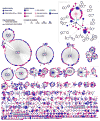Global phenotypic screening for antimalarials
- PMID: 22284359
- PMCID: PMC3269778
- DOI: 10.1016/j.chembiol.2012.01.004
Global phenotypic screening for antimalarials
Abstract
Malaria, a devastating infectious disease caused by Plasmodium spp., leads to roughly 655,000 deaths per year, mostly of African children. To compound the problem, drug resistance has emerged to all classical antimalarials and may be emerging for artemisinin-based combination therapies. To address the need for new antimalarials with novel mechanisms, several groups carried out phenotypic screening campaigns to identify compounds inhibiting growth of the blood stages of Plasmodium falciparum. In this review, we describe the characterization of these compounds, explore currently ongoing strategies to develop lead molecules, and endorse the concept of a "malaria box" of publicly accessible active compounds.
Copyright © 2012 Elsevier Ltd. All rights reserved.
Figures




References
-
- Adjalley SH, Johnston GL, Li T, Eastman RT, Ekland EH, Eappen AG, Richman A, Sim BK, Lee MC, Hoffman SL, et al. Quantitative assessment of Plasmodium falciparum sexual development reveals potent transmission-blocking activity by methylene blue. Proceedings of the National Academy of Sciences of the United States of America. 2011;108:E1214–1223. - PMC - PubMed
-
- Allu TK, Oprea TI. Rapid evaluation of synthetic and molecular complexity for in silico chemistry. Journal of chemical information and modeling. 2005;45:1237–1243. - PubMed
-
- . In: Antimalarial Drug Combination Therapy. Geyer M, editor. Roll Back Malaria/WHO; Geneva: 2001.
-
- Bahamontes-Rosa N, Rodriguez-Alejandre A, Gonzalez-Del-Rio R, Garcia-Bustos JF, Mendoza-Losana A. A new molecular approach for cidal vs static antimalarial determination by quantifying mRNA levels. Molecular and biochemical parasitology 2011 - PubMed
Publication types
MeSH terms
Substances
Grants and funding
LinkOut - more resources
Full Text Sources
Other Literature Sources
Medical
Miscellaneous

